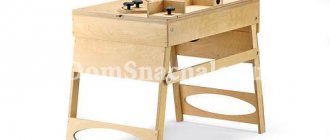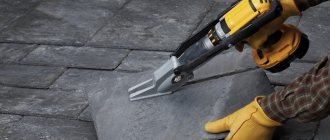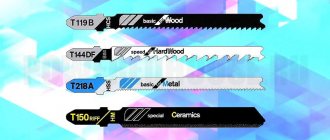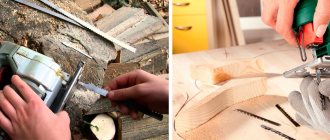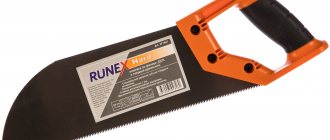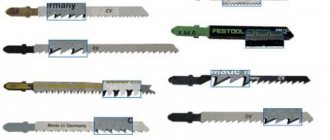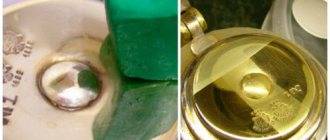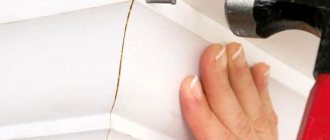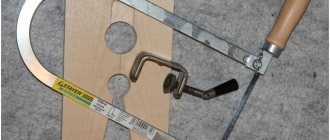A jigsaw is used to perform a curved cut, and in order to achieve convenience in production processes and increase productivity, it is equipped with an electric drive.
All kinds of accessories are supplied with the power tool to simplify the cutting procedure and improve the quality of the cut. Such devices can either be obtained together with a jigsaw, purchased separately at a power tools store, or made independently.
Why does a jigsaw cut crookedly and how to fix it
In most cases, the process of straight and figured cutting of materials requires extreme precision of the tool. This statement is most true for an electric jigsaw. The thin saw blades used in this device can easily change the cutting angle, which can negatively affect the accuracy of the line. The clarity of the edges of the product and the evenness of the cutting line depend on the skills of the operator, the serviceability of the device and the saw. Next, we will tell you how to get the planned contour with perfectly clear edges and what to do if the jigsaw moves to the side.
Why does a jigsaw cut crookedly?
The saw blade leaving the pre-planned line may be due to several reasons. The operator may not have enough experience in handling the tool, the file may be defective, and the rod and guide roller for the jigsaw may have serious play. In order not to guess from the coffee grounds, it is worth starting to sift out the factors that determine the accuracy and evenness of the cut line in your individual case.
As usual, it’s better to start with yourself and your approach to sawing. Often, novice craftsmen rush things and, wanting to speed up the cutting, apply a lot of pressure to the jigsaw. The tool does not have time to bite evenly into the material and create a clear groove for the file, which begins to follow the path of least resistance and makes unpredictable movements. This problem is especially common when working with thick timber (from 40 mm) and varnished plywood from Soviet times.
This is one of the reasons why the jigsaw moves to the side. What to do about this? The answer is obvious. Apply the minimum pressure sufficient to guide the tool along the line and set the maximum number of revolutions (when working with wood). The pendulum mode usually does not affect the evenness of the cut if its design is in good order.
The quality of assembly and wear of tool parts can be a good reason for the formation of beveled lines when sawing. There are basically no complaints about devices from the budget segment (up to 2,500 rubles), as well as hopes for their conscientious assembly. It’s another matter when original, branded instruments begin to perform such tricks. Often, the cause of a crooked cut is the guide roller, the jigsaw rod or its sole.
You can check the reliability of the element’s fixation by simply tugging it with your hand. Loosening of the rod or roller by more than 1 mm determines that this device is not capable of producing a perfectly even cut. The more play there is in the parts, the less accurate the cutting line they form. This problem should be corrected based on the circumstances. If the part itself is worn out, it can be replaced with a similar one. It is difficult to fix a breakdown if the attachment point to the mechanism is worn out. Not every modern Kulibin undertakes such repairs, and this problem is usually solved by purchasing a new tool.
Unfortunately, the products of many trusted brands are often counterfeited, and jigsaw files are very popular in this regard. It so happens that low-quality and counterfeit products have a rather short service life, which brings many problems to the owner. One of these problems is a crooked cut. An initially smooth blade can bend due to poor-quality metal, which can cause deformation of the tooth set, if it was present at all. In this regard, if your jigsaw cuts crookedly, replacing the saw blade can correct the situation. The process of choosing a high-quality jigsaw file was discussed in detail in a separate topic.
Blade clamp repair
Not every manufacturer of power tools uses high-quality materials, which is why their service life may even be disposable. Frequent breakdowns, especially due to pressure on the tool, also occur with the jigsaw blade clamp. Below we will describe the course of action to eliminate a broken block fastening.
During prolonged cutting, the jigsaw block clamp may become deformed, because there is a serious load on the saw attachment. The breakdown may be easily repairable, the file may be slightly deformed or cannot be repaired at all.
To restore the operation of a jigsaw, the easiest way is to buy and install a new block of the same type. This part can be purchased at markets and hardware stores. Of course, this does not mean that the new mount will be better, but the main thing is that the tool can be used.
Guide rail for jigsaw
The guide for a jigsaw is a simple device, at first glance, similar to a large metal ruler or rule. The main difference between the tire and the above devices is a special groove along which, like on rails, the sole with a jigsaw mounted on it moves. Most guides have rubberized strips that prevent sliding on the surface of the material, and for additional fixation, they are attached with small clamps. The average length of such devices is from 1.5 to 3 meters, and can be increased by another, similar ruler, using an adapter.
Tabletop
This is an ordinary stove without legs, which is fixed to the edge of the main work table/workbench. A striking example of such a device is the table for the jigsaw Phiolent (Fiolent) .
The table for the Phiolent jigsaw is represented by a metal plate, which is rigidly fixed to the edge of the workbench with a pair of clamps. To securely fix the jigsaw, the set includes 4 brackets, which are secured using convenient screw clamps. Additionally, the jigsaw table is equipped with a guide bar, which allows you to trim workpieces, as well as make smooth, fast and accurate longitudinal cuts.
The Phiolent kit costs about $10-$12 . You can install almost any jigsaw model on the stove.
The main disadvantage of this set is the absence of a vertical stop bar, which prevents the blade from deviating back and to the sides. But you can make and install the thrust bar yourself. Below is a video on how to modify a table for a Phiolent jigsaw.
DIY jigsaw guide
If a jigsaw cuts crookedly, and it is not advisable to buy an expensive guide, you can completely get by with improvised means. Any smooth edge with a thickness of 5 mm or more can become an impromptu stop: a straight strip, usually a piece of plywood and other straight surfaces of suitable sizes. A pair of ordinary clamps can serve as clamps for the guide to the material. If the condition of the surface of the opposite part of the material being sawn is not of great importance, the guide can be screwed onto a pair of self-tapping screws.
To make the line as neat and even as possible, use the optimal file suitable for the material being processed. More visual processes for making and using a homemade guide are demonstrated in the following videos.
Guide fence for electric jigsaw
A jigsaw guide can be purchased at the store. It is a special aluminum profile with a T-shaped groove on the bottom side for the unhindered movement of clamps.
On the upper side, the guide has two T-shaped grooves into which devices are inserted to fix the power tool and allow it to move freely along the ruler. Clamps are supplied with the guide; accessories are sold separately.
The ruler is attached to the workpiece with clamps, and the cutting is carried out with a jigsaw. If there is no device for fixing the tool, then during the cutting process the jigsaw is pressed against the guide with the side of the sole.
You can make a guide ruler at home. To do this you need:
- Take a timber without knots, 1.9 meters long. This is a more acceptable size, because the cutting width of chipboard and laminated chipboard sheets is 1830 mm.
- All surfaces of the timber are processed in compliance with strict perpendicularity relative to each other.
- After this, a groove is made on the bottom side and a T-shaped profile is inserted. Clamps will be placed in it to secure the ruler to the workpiece.
- Graduation is attached to the outside. To do this, you can use metal rulers, attaching them with round-head screws.
Cutting is carried out by moving the jigsaw with the edge of the sole resting on the side surface of the guide ruler.
Attachments for electric jigsaw
The attachments for a jigsaw are nothing more than a regular saw blade. A jigsaw cutting tool can be classified according to the following criteria:
- physical properties of the processed material;
- tooth shape;
- file geometry;
- tooth pitch;
- saw blade width;
- saw blade thickness.
Each material has its own hardness and resists the cutting process differently. Wood and plastic are soft, while metal and its alloys, as well as some polymers, are hard. Therefore, there are several types of jigsaw files corresponding to the hardness of the material being processed.
The quality of the cut depends on the shape of the saw blade tooth. If the teeth are small, it is recommended to cut slowly. The result is a precise and neat cut. The presence of most large teeth makes it rough, one might say rough. But such an operation is performed quickly.
The geometry of the tooth directly depends on the technological process of saw blade production. They can be milled and ground. The use of one or another blade manufacturing technology depends on the material and the required cut quality.
The thickness, width and pitch of the teeth of the saw blade have a great influence on the quality and speed of the cut.
Cylindrical shafts
The design of the cylindrical shafts allows you to maintain the level along the entire length, completely eliminating sagging under the weight of the carriage or your own. Such guides are also called linear support shafts; they are fixed directly to the body of the CNC machine through the threaded holes provided in the supports. Large carriages can move along such guides without sagging.
Disadvantages of cylindrical shafts:
- short service life;
- noticeable play in the bushings.
If linear-type bearings work equally well with loads in different directions, then carriages on cylindrical shafts show less stability. This is explained by the closed surface of the bushings, which carriages do not have. Therefore, you should be prepared for the fact that a small CNC machine with a heavy carriage on support shafts will operate with a greater error than the same CNC machine on conventional round rails.
The technology for manufacturing cylindrical rails is very simple, so they are produced by both well-known companies and handicraft workshops. This explains the variation in technical characteristics and prices. Often, carriages and rails from the same “know name” manufacturer do not match.
Universal miter box from Bosch for power tools
Another great attachment for a jigsaw is the portable Bosch Saw Station PLS 300. This is nothing more than a universal miter box.
It is convenient to cut laminate, parquet or regular boards up to 30 cm wide and 2.5 cm thick. In addition, you can cut narrow slats and plinths. The design of the device allows cutting at an angle from 0 to 90°. In addition to wood, the machine can cut aluminum profiles and ceramic tiles.
Linear motion technique. Mechanical components.
Detailed descriptions, catalogs and engineering information are located within individual subsections. If necessary, our specialists will help you select the most suitable products for your task.
Guiding mechanisms:
- High load capacity
- High accuracy
- Self-centering
- Compactness
- In stock
Drive mechanisms and devices:
- High efficiency
- High accuracy
- High load capacity
- In stock
Electromechanical linear actuators
- Actions
- Search for spare parts from other manufacturers
- Go to catalog library
- EcoPRO products - inexpensive solutions for professionals
- Products sorted by category
- Guides
- Ball profile rail guides
- Roller profile rail guides
- Ball bushings
- Linear blocks
- Precision round shafts and bearings
- Spline shafts
- Precision rail guides and tables based on them
- Guide protection systems
- Lubricant for linear guides and ball screws
- Drive technology
- Ball Screws, Roller Screws, Supports
- Racks and Gears
- Actuators and positioning systems
- Coordinate tables
- Linear modules
- Electromechanical Rod Linear Actuators
- Other product groups
- Electric drives and electronics
- Industrial pneumatics
- Ready-made systems
- Other products
LLC "Aketon"
Official distributor of NB in Russia and the former CIS countries. Direct deliveries of industrial goods and components from Japan, Europe, America.
Copyright 2006-2020 Aketon LLC, All rights reserved.
105523, Russia, Moscow, Shchelkovskoe highway, 100, bldg. 6, office 202 (diagram)
Rip fence for electric jigsaws
A mandatory accessory on a power tool is the rip fence. This device allows you to perform a parallel cut relative to the edge of the workpiece. The device is a rectangular rod with a perpendicular stop at its end.
The use of the device consists of installing a stop at a distance corresponding to the size of the future cut and fixing the rod on the base of the tool with a screw. In inexpensive models of jigsaws, a parallel stop is included with the tool; in expensive models, this accessory is usually absent and must be purchased separately. The cost of such a device is rather high, so many craftsmen prefer to make the device themselves.
DIY parallel fence for a jigsaw: instructions
- For manufacturing you will need a metal strip 2 mm thick and 350 mm long. The width of the strip is selected according to the size of the bracket on the sole of the jigsaw. If there is none, you will need to do it yourself.
- To do this, you need to drill 2 holes with a diameter of 4–5 mm in the base of the power tool. Then threads are cut into them. Then, from a 2 mm thick strip, 2 brackets are bent along the profile of the rod, having previously drilled holes in them for fasteners and a fixing screw. A thread is cut into the hole for the screw. The brackets are installed on the sole of the jigsaw and secured.
- After this, a corner 80–100 mm long is welded perpendicular to the rod. The bar is bent in the opposite direction through the upper shelf of the corner. In this case, the distance between the surface of the angle shelf and the bottom side of the rod should be equal to the thickness of the jigsaw sole. The free end of the device is inserted into the brackets on the sole and secured with wing screws.
DIY jigsaw compass
Another device that will come in handy in a carpentry workshop is a jigsaw compass. Not very often, but sometimes you have to cut out round parts. It is quite difficult to make the circle even according to the markings. But a DIY device will help with this.
- You need to take a sheet of thick plywood and cut a strip from it as wide as the sole of a jigsaw. The length of the workpiece is arbitrary. Depends on the size of the radius of the future circle.
- Then you need to install the jigsaw on the edge of the strip. To do this you need to make a cut.
- After installation, the base of the power tool is framed with slats and attached to the strip in the areas of the technological holes.
- A line is drawn from the middle of the canvas on the plywood, the required radius of the circle is measured on it and a self-tapping screw is screwed in.
- After this, install the device on the workpiece with a self-tapping screw in the center of the circle. If necessary, drill a hole for the saw blade.
Security Recommendations
When working with a jigsaw-type machine, you should adhere to the following rules:
Moreover, it is also worth remembering about fire safety rules and always unplug the device from the socket after finishing work. Making a jigsaw machine with your own hands will not be difficult, but not all craftsmen need it. Typically, such devices are used by people who do a large amount of work and need optimal conditions.
Jigsaw: LED cutting line lighting
When operating a jigsaw in poorly lit areas, it is advisable to illuminate the cutting line. You can make such a device yourself.
The lighting design is very simple and will require a few inexpensive parts:
- LED (you can use two).
- Capacitor 0.22 uF, 400 volts.
- Diode.
- Discharge resistor 500–1000 kOhm.
- Resistor 1 kOhm.
The circuit is connected to the power tool power button instead of a 0.22 µF 250 volt interference capacitor. The capacitance could have been left, but our circuit already has a 0.22 uF 400 volt capacitor, so in the fight for free space it is better to remove it.
A discharge resistor from 500 kOhm to 1 mOhm is connected in parallel to the capacitor. At the next stage of work, a diode is connected to the circuit with the cathode to the capacitor and in parallel to it an LED with the anode to the capacitor. A 1 kOhm resistor is installed behind them.
The peculiarity of this resistor is that it can heat up during operation, so it is better not to use low-resistance devices. Heating occurs within 10 minutes of continuous operation of the tool, so install the resistor so that it does not touch anything. It only takes a few seconds to cool down.
Since the circuit is connected to the start button, the backlight starts working even a little faster than the engine turns on. You can also use two LEDs in this circuit, then the light will be much brighter. In this case, the LEDs are connected in series.
After reading the information presented in the article, the master will be able to improve the quality of the cut and make it easier to perform operations using a jigsaw in general by purchasing or manufacturing various devices.
How to choose a good circular saw?
When purchasing a hand-held circular saw, the buyer should pay attention to the following parameters and technical characteristics of the tool:
- engine power. It determines how much work the unit can perform, how successfully it will cope with the task and whether it will cut thick, rough wood;
- cutting depth. It should be enough for the operator to cut the necessary materials and workpieces;
- cut at an angle. This makes the circular saw more functional and significantly expands its capabilities;
- the presence of a lock for accidental pressing of the “start” button, which increases operational safety;
- the presence of additional functions: protection against overheating, connecting a vacuum cleaner, blowing sawdust, etc.
For more detailed selection criteria, watch the video:
Features of jigsaw guides
A jigsaw is a necessary tool on the farm. The good news is that there is a huge selection of models for this product. There are manual, electric hand and stationary tools, the purpose of which is curved cutting of various materials from chipboard to metal. This is achieved by various elements included in the design of modern electric jigsaws. Let's look at some of the jigsaw accessories called guides.
Materials used
To make a homemade tabletop jigsaw you will need the following:
- block of wood;
- electric motor;
- metal plates;
- saw;
- plywood;
- plastic;
- bicycle spoke;
- gas stove nozzle;
- nuts, bolts, screws.
To make a jigsaw, you also need to prepare your tools. This may require metal scissors, a hacksaw, pliers, a pencil, or a drill with drill bits.
Note! The list of materials and tools may vary. The above list should be used as a guide, but other accessories may be required depending on the design.
Peculiarities
The operation of the jigsaw can be adjusted by the following elements.
- By tilting the sole, due to which you can make oblique cuts. Used quite rarely.
- Stroke frequency, thereby adapting to the material. If they work with wooden materials, then use the maximum frequency, in other cases - the average.
- Pendulum motion of the canvas. This regulates the vertical and longitudinal movements of the tool.
But the accuracy and quality of cuts are ensured and controlled by the jigsaw’s guide elements. These include the following devices: guide rail, support roller, ruler and laser illumination. The latter, however, is not present on all jigsaw models.
Let's take a closer look at the various jigsaw guides.
Support roller
This part of the tool is a wheel that guides the main working body (the file) and at the same time serves as a support for it, absorbing the forces on the file from the process of cutting a particular material. The function is actively revealed when the volume of work and the dimensions of the workpiece are large. When using a pendulum stroke, the saw blades begin to move more efficiently - not only down and up, but also back and forth. At the same time, dust and sawdust are better removed from the groove being cut, which means the jigsaw produces a better quality cut.
The support roller is a necessary part in a jigsaw; without it, neither high-quality cutting nor long-term operation of the engine, files and other elements are possible. Due to frequent jamming and jamming of the saw blade in the material, overheating of the moving mechanisms and overload of the electric motor would occur. And this all leads to their rapid wear and failure.
For the quality of the video to work, the following rules must be observed:
- cutting blades must be of good quality;
- threading modes must comply with the instructions supplied with the tool;
- Do not allow wood shavings to get into the roller, and after use, clean the product from dust and debris.
Guide rail
This is a simple piece that resembles a large ruler; it can be up to 1.5 meters long. The tire is made of metal, often aluminum. It has a groove in which the sole of the jigsaw is located and it moves along it. The guide may have rubber strips on its base that prevent sliding along the workpiece. The clamps for the tire are small clamps.
Some features when choosing a jigsaw tire:
- the price is determined by the size, quality of the materials used, as well as the brand, which indicates the durability of the tires used;
- it is important to use only products from trusted companies to avoid damage to essential equipment and situations associated with injuries;
- if you use significant force when cutting, you can damage the tire and material;
- Lack of lubrication leads to overheating of the tire.
There is a peculiarity when choosing a tire for each tool. There is a wide variety of them on the market, but each brand produces this auxiliary device only for its specific models, thereby reducing the versatility of the jigsaw addition to a minimum.
Rip fence
The device necessary for straight cutting: aligns the edges, makes a high-quality cut at the edge of the workpiece. The stop is similar to the letter “T” and consists of a fixing bar and a long ruler attached to the body of the jigsaw.
Jigsaw Diold: a budget option for the household
Another, no less popular manufacturer of domestic power tools is the Smolensk company Diold. Jigsaws are distinguished by their low price and fairly decent quality. For home work, this is a completely suitable budget option.
Support roller repair
It also has points that are worth paying attention to. The first is the support roller
Over time, which is about a year, it begins to lose its round shape. The reason is the material of the roller or the technology of its manufacture. It lacks hardness.
Its repair consists of replacement. Still, it is better not to reinvent the wheel, but to purchase an original roller from the manufacturer or take the tool to a service center, especially if it is under warranty.
If this option is not suitable or is not feasible, then you can revive the jigsaw using improvised means. To do this you will need a regular M5 bolt with a nut. In this case, the bolt will serve as an axis, so the thread on it needs to be ground off, and the nut with a roller, in which a groove needs to be cut along the generatrix according to the thickness of the saw blade.
It is ideal to do this on a lathe, but you can also use a tool that you have on hand, for example, a drill and an angle grinder disc. The disk must be clamped in a vice, the bolt and nut must be clamped into a drill and a groove must be cut. The repair option is not ideal, but it has the right to life, since it has been tested in practice.
Start Button Maintenance
Another nuance in using a Diold jigsaw is that wood dust gets into the start button. This happens due to the lack of tightness, and dust getting inside the button prevents the passage of current. The solution to the problem is to periodically, at least once a year, clean the contacts.
